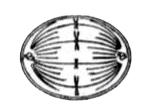It is not related to replacement of degenerated red blood cells by new ones
Growth through undifferentiated
Growth through reserved cells
Multiplication growth
Accretionary growth.
The correct Answer is:C
To solve the question "It is not related to replacement of degenerated red blood cells by new ones," we need to analyze the options provided and determine which one does not relate to the replacement of degenerated red blood cells (RBCs).
1. Understanding the Replacement of RBCs:
- Red blood cells have a limited lifespan and are continuously replaced in the body. The replacement occurs through specific types of cells known as reserve or undifferentiated cells.
2. Analyzing the Options:
- Growth through Undifferentiated Reserve Cells: This type of growth is directly related to the replacement of degenerated RBCs. Undifferentiated reserve cells can divide and generate new RBCs when needed. Therefore, this option is related to the replacement process.
- Multiplication Growth: This refers to an increase in the number of cells. While RBCs themselves do not multiply directly to replace themselves, the process of multiplication growth can contribute to the overall increase in cell numbers, including RBCs. However, since RBCs are replaced through reserve cells, this option can be considered indirectly related but not a direct mechanism for RBC replacement.
- Accretionary Growth: This type of growth refers to the increase in cell size or mass rather than cell number. It is also related to the growth process but does not directly pertain to the replacement of degenerated RBCs. Thus, this option is also not directly related to the replacement of RBCs.
3. Identifying the Correct Answer:
- Since the question asks for the option that is not related to the replacement of degenerated RBCs, we find that both "Multiplication Growth" and "Accretionary Growth" do not directly relate to the replacement of RBCs. However, "Multiplication Growth" can still be seen as indirectly related due to the increase in cell numbers.
4. Conclusion:
- Therefore, the option that is least related to the replacement of degenerated red blood cells is Accretionary Growth.
Final Answer:
Accretionary Growth is not related to the replacement of degenerated red blood cells by new ones.
---
- Red blood cells have a limited lifespan and are continuously replaced in the body. The replacement occurs through specific types of cells known as reserve or undifferentiated cells.
- Growth through Undifferentiated Reserve Cells: This type of growth is directly related to the replacement of degenerated RBCs. Undifferentiated reserve cells can divide and generate new RBCs when needed. Therefore, this option is related to the replacement process.
- Multiplication Growth: This refers to an increase in the number of cells. While RBCs themselves do not multiply directly to replace themselves, the process of multiplication growth can contribute to the overall increase in cell numbers, including RBCs. However, since RBCs are replaced through reserve cells, this option can be considered indirectly related but not a direct mechanism for RBC replacement.
- Accretionary Growth: This type of growth refers to the increase in cell size or mass rather than cell number. It is also related to the growth process but does not directly pertain to the replacement of degenerated RBCs. Thus, this option is also not directly related to the replacement of RBCs.
- Since the question asks for the option that is not related to the replacement of degenerated RBCs, we find that both "Multiplication Growth" and "Accretionary Growth" do not directly relate to the replacement of RBCs. However, "Multiplication Growth" can still be seen as indirectly related due to the increase in cell numbers.
- Therefore, the option that is least related to the replacement of degenerated red blood cells is Accretionary Growth.
Accretionary Growth is not related to the replacement of degenerated red blood cells by new ones.
Topper's Solved these Questions
- BOOK - DINESH PUBLICATION ENGLISHCHAPTER - GROWTH, REPAIR, REGENERATION AND AGEINGEXERCISE - Check your Grasp10videos
GROWTH, REPAIR, REGENERATION AND AGEING
- BOOK - DINESH PUBLICATION ENGLISHCHAPTER - GROWTH, REPAIR, REGENERATION AND AGEINGEXERCISE - Brain Teasers-VI[B]6videos
GROWTH, REPAIR, REGENERATION AND AGEING
- BOOK - DINESH PUBLICATION ENGLISHCHAPTER - GROWTH, REPAIR, REGENERATION AND AGEINGEXERCISE - Brain Teasers-VI[B]6videos
GROWTH, REPAIR, REGENERATION AND AGEING
- BOOK - DINESH PUBLICATION ENGLISHCHAPTER - GENETIC BASIS OF INHERITANCEEXERCISE - Check your Grasp30videos
GENETIC BASIS OF INHERITANCE
- BOOK - DINESH PUBLICATION ENGLISHCHAPTER - HUMAN EVOLUTIONEXERCISE - Brain Teasers-VII181videos
HUMAN EVOLUTION
Similar Questions
The pigment present in red blood cells.
View SolutionThe colour of the red blood cells is due to
View SolutionDescribe the functions of the Red blood cells
View Solutionred blood cells and white blood cells.
View SolutionName the group of animals which have red blood cells.
View SolutionABO blood groups are dependent on _______ present on plamsa membrane of the red blood cells and protrude from its surface
View SolutionMineral found in red pigment of vertebrate blood is
View SolutionName the following:
The pigment present in red blood cells.View SolutionThe diagram given below represents a stage during cell division
Study the same and answer the questions that follow :

Name the type of cell division that occurs during:
Replacement of old leaves by new ones.
Formation of gametesView SolutionFormation of red blood is called
View Solution

